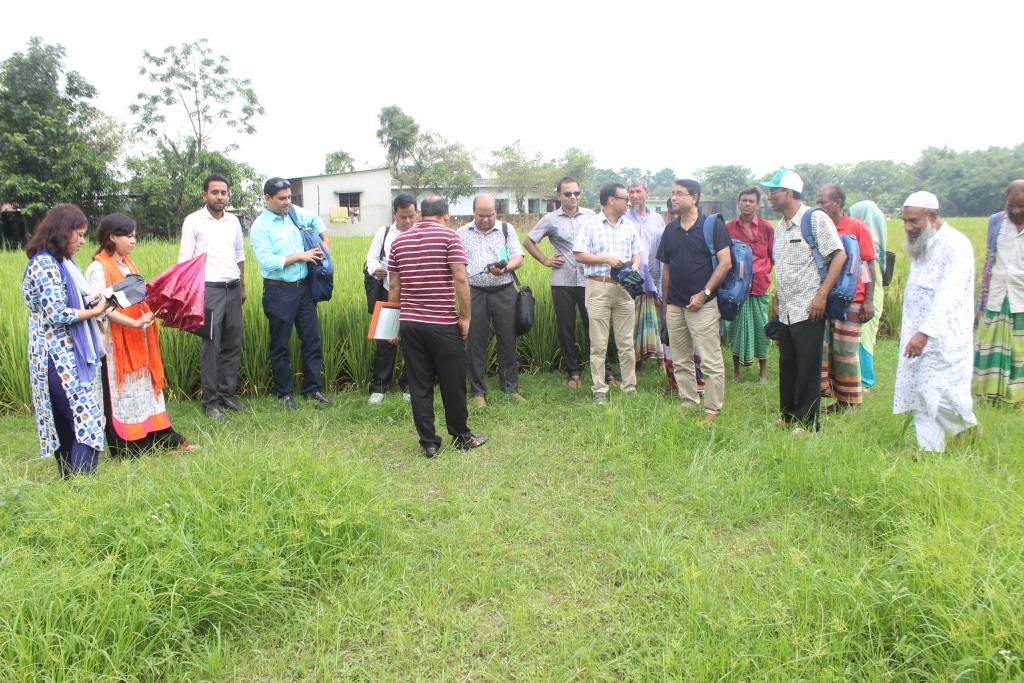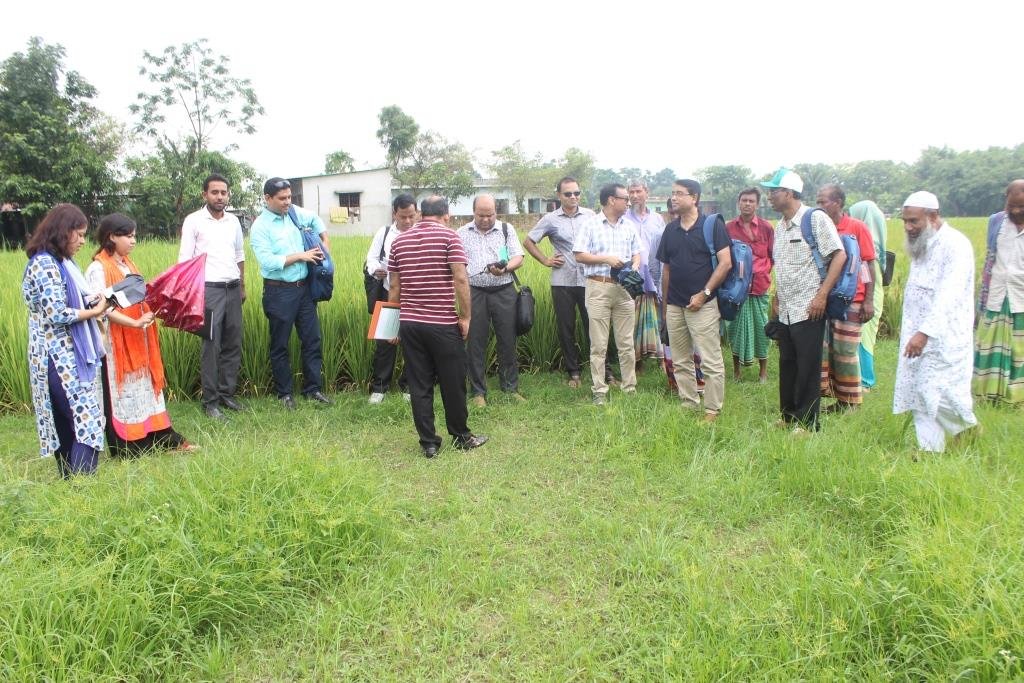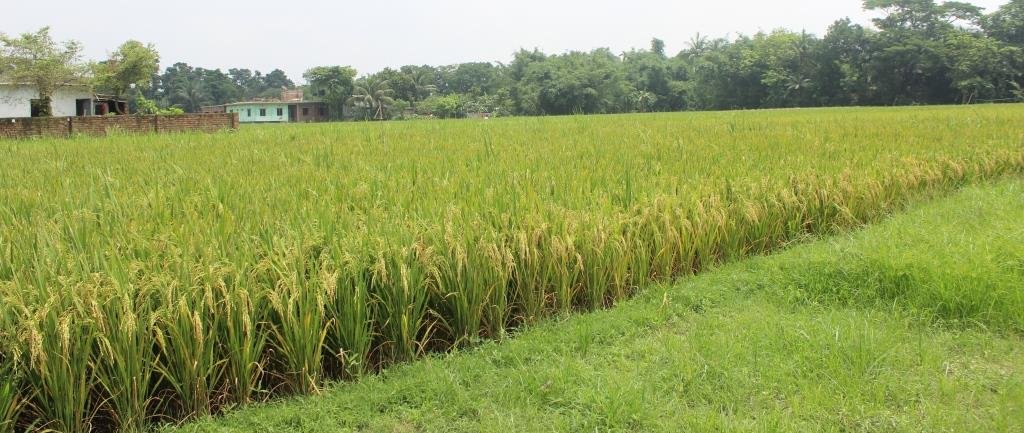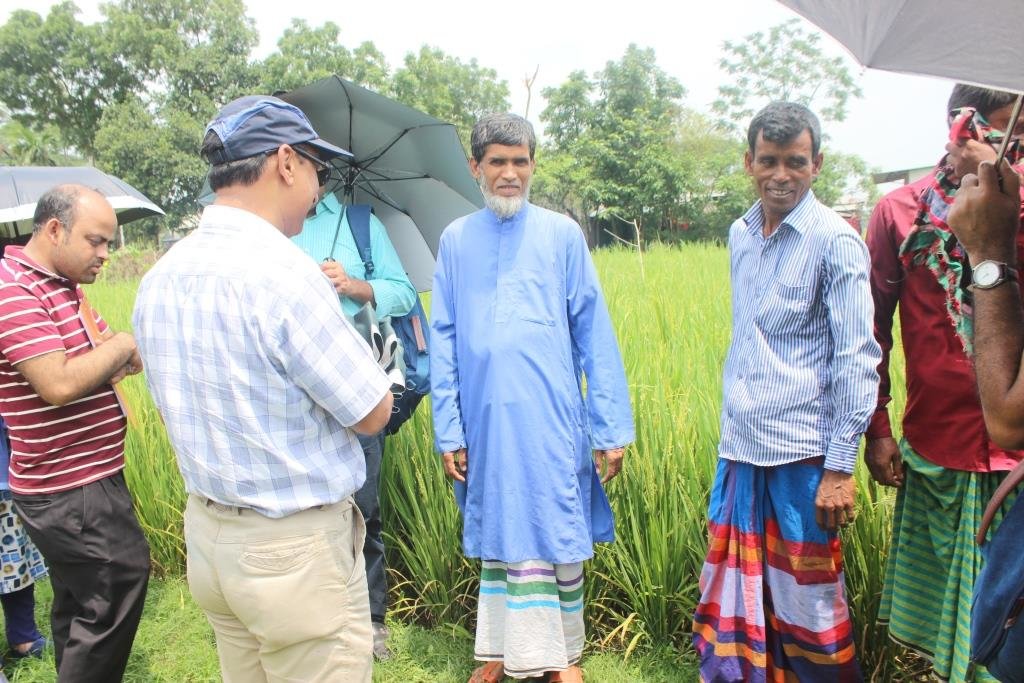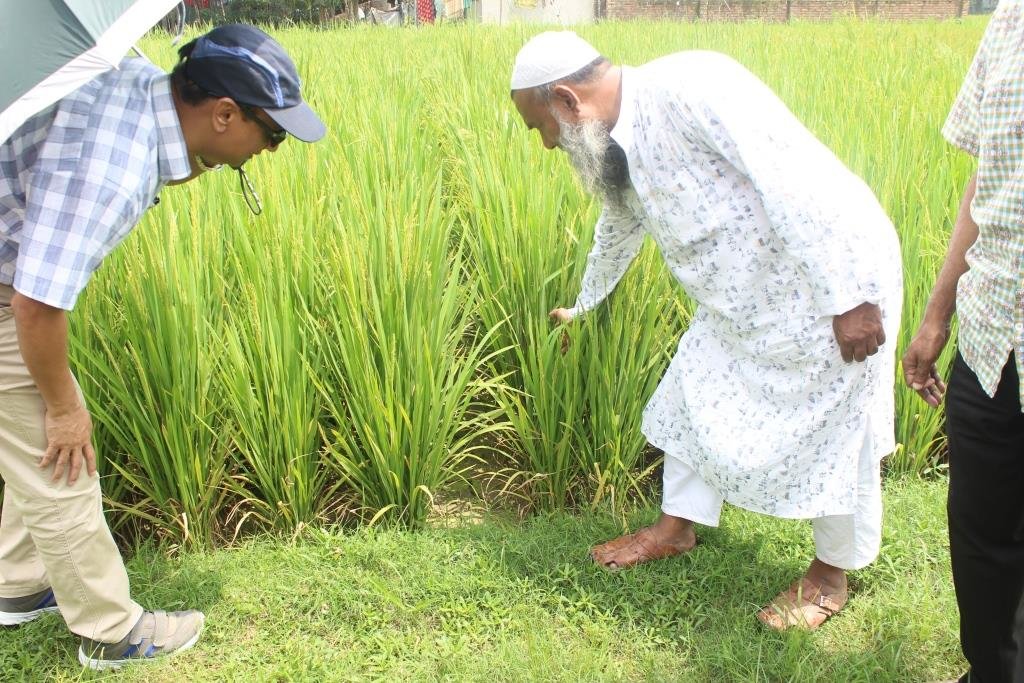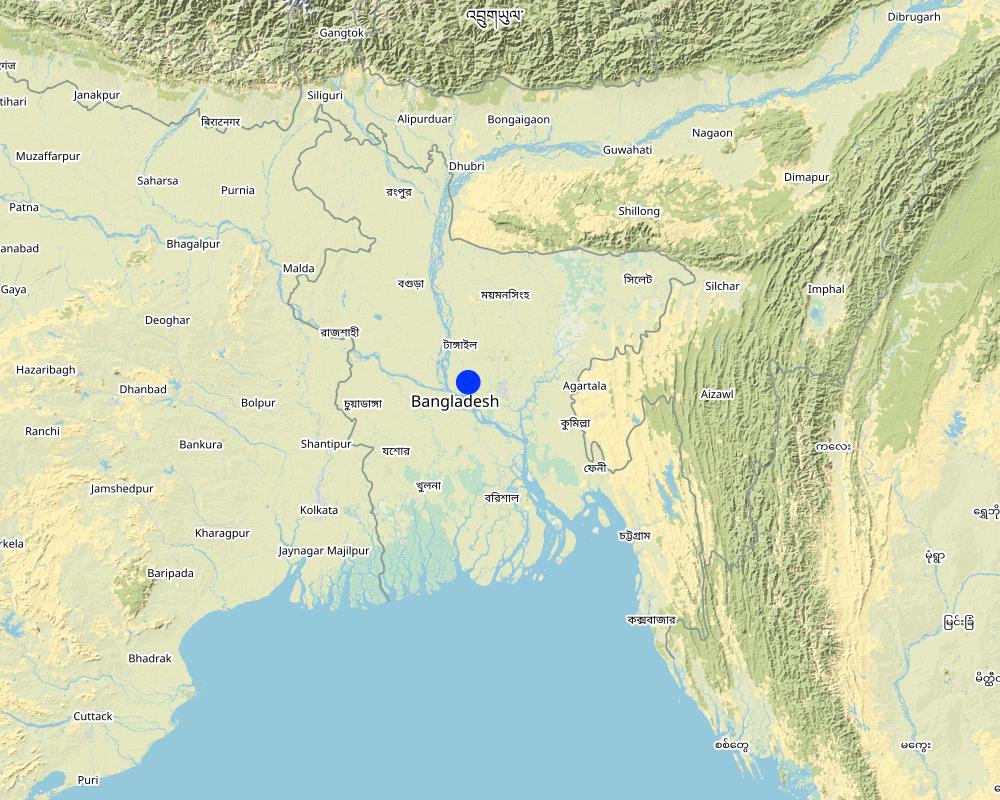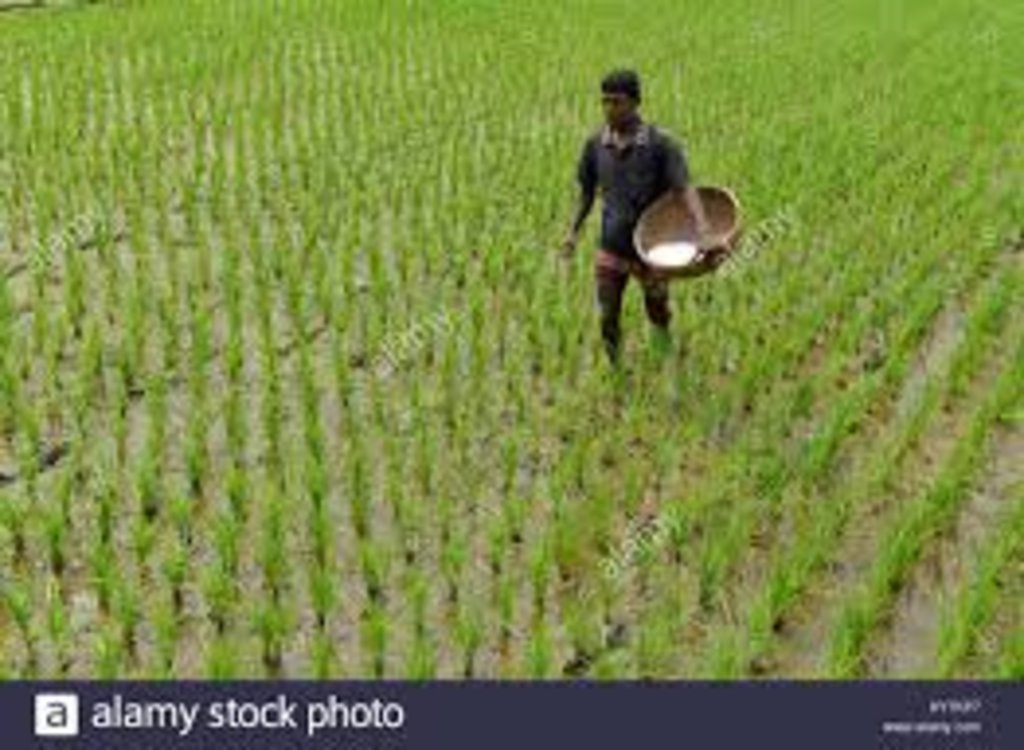Application of balanced fertiliser to improve soil productivity [Bangladesh]
- Creation:
- Update:
- Compiler: Md Babul Hossain
- Editor: –
- Reviewers: Alexandra Gavilano, Udo Höggel, Joana Eichenberger
Shusomo shar babohar
technologies_3852 - Bangladesh
View sections
Expand all Collapse all1. General information
1.2 Contact details of resource persons and institutions involved in the assessment and documentation of the Technology
Key resource person(s)
land user:
Alam Khorshed
Bangladesh
land user:
Jainul Abedin
Bangladesh
SLM specialist:
Md Zahid Ameer
Soil Resource Development Institute
Bangladesh
SLM specialist:
Razzaque Abdur
Department of Agriculture Extension
Bangladesh
SLM specialist:
Islam Md Nurul
soil resoiurce development institute
Bangladesh
SLM specialist:
Tazrian Sarwat
CEGIS
Bangladesh
SLM specialist:
Islam A.T.M. Rafiqul
BMDA
Bangladesh
Name of the institution(s) which facilitated the documentation/ evaluation of the Technology (if relevant)
Soil Resource Development Institute (SRDI) (Soil Resource Development Institute (SRDI)) - BangladeshName of the institution(s) which facilitated the documentation/ evaluation of the Technology (if relevant)
BANCAT (BANCAT) - BangladeshName of the institution(s) which facilitated the documentation/ evaluation of the Technology (if relevant)
Institue of forestry and Environmental Sciences (Institue of forestry and Environmental Sciences) - Bangladesh1.3 Conditions regarding the use of data documented through WOCAT
The compiler and key resource person(s) accept the conditions regarding the use of data documented through WOCAT:
Ja
1.4 Declaration on sustainability of the described Technology
Is the Technology described here problematic with regard to land degradation, so that it cannot be declared a sustainable land management technology?
Nee
Comments:
The technology is perfectly suitable for mitigating land degradation as well as it conserves soil health in a highly populated country like Bangladesh.
2. Description of the SLM Technology
2.1 Short description of the Technology
Definition of the Technology:
Balanced fertiliser use( Shusomo shar babohar) technology is absolutely suitable for reducing land degradation as well as increasing crop productivity,
2.2 Detailed description of the Technology
Description:
Land degradation is one of the major concern of the globe. Land degradation means loss in the capacity of a given land to support growth of useful plants on a sustained basis (Singh,1994). It results from many factors or/and combination of factors which damage the soil, water and vegetation resources and restrict their use or production capacity. Considering its impact on food security and environment, it is being important in many corners of the world. The productivity of some lands has declined by 50% due to soil erosion, fertility decline and desertification of the world. Like other countries, Bangladesh is not exception in facing threat of land degradation. Due to different types of land degradation, Bangladesh lost a substantial amount of production which in terms of hundreds of billion taka in every year (BARC, 1999). It is high time to be conscious to minimize the land degradation in Bangladesh, a small country with 1, 47,570 sq. km and about 140 million people. The ever-increasing growth rates (1.48%) caused a spurt in all round consumption level. To meet up the demand of the present and forthcoming generation it is essential to sustain soil fertility and increase crop productivity.
Considering the presentation land degradation scenario of Bangladesh, the farmers of Manikgong have adopted the SLM technology named ' balanced fertiliser use to minimise land degradation as well as increase crop productivity'. The technology has been approached by DAE personnel under "Farmers' advisory services program" in Manikgong district of Bangladesh. The balanced fertiliser recommendation has been made according to the suggestion of soil resource development institute. The SLM specialists have compiled database regarding the technology from Dhalla union of Singair upazila under Manikgong district. The technology included applying different types of fertiliser like compost, Urea( Nitrogen), TSP
( phosphorus), MOP( potassium), Zypsum( sulphur), Zinc Sulphate( zinc+ sulphur) etc. Compost, Urea, TSP, MOP, Zypsum and Zinc Sulphate are applied at the rate of 5 ton, 265kg/ha, 90kg/ha, 145 kg/ha, 100 kg/ha and 8.5 kg respectively. The main purpose of the technology was to improve soil nutrient status by using balanced fertiliser along with organic farming. The technology provides multidimensional advantages for the stakeholders. It prevents nutrient mining decline, improves soil physical ,chemical and biological conditions,increase water holding capacity of the soil, increase crop productivity and improve socio-economic conditions of the land users. Overall, it conserves soil health. The farmers community have accepted the well established methods of balanced fertiliser use. Because they are absolutely benefitted by this technology, crop yield has increased manifolds, soil fertility increrased, land cover also increased. As the farm income has increased, the socio-economic condition of the land user has changed dramatically and in the long run it wIll mitigate the climate change impacts by reducing land degradation problem throughout the country.
2.3 Photos of the Technology
General remarks regarding photos:
SLM Specialist are investigating different beneficial aspects of line sowing.
2.5 Country/ region/ locations where the Technology has been applied and which are covered by this assessment
Country:
Bangladesh
Region/ State/ Province:
Manikgong
Further specification of location:
Its a region
Specify the spread of the Technology:
- evenly spread over an area
If the Technology is evenly spread over an area, specify area covered (in km2):
100.0
Is/are the technology site(s) located in a permanently protected area?
Nee
Map
×2.6 Date of implementation
Indicate year of implementation:
1900
If precise year is not known, indicate approximate date:
- less than 10 years ago (recently)
2.7 Introduction of the Technology
- Advisory services of DAE
Comments (type of project, etc.):
SFFP project of DAE
3. Classification of the SLM Technology
3.1 Main purpose(s) of the Technology
- improve production
- reduce, prevent, restore land degradation
- conserve ecosystem
- preserve/ improve biodiversity
- adapt to climate change/ extremes and its impacts
- create beneficial social impact
3.2 Current land use type(s) where the Technology is applied

Cropland
- Annual cropping
Number of growing seasons per year:
- 3
Specify:
Rabi vegetables-irrigated rice- Rain fed rice AMAN
Is intercropping practiced?
Nee
Is crop rotation practiced?
Ja
If yes, specify:
dry season vegetables- rainfed rice
3.3 Has land use changed due to the implementation of the Technology?
Has land use changed due to the implementation of the Technology?
- No (Continue with question 3.4)
3.4 Water supply
Water supply for the land on which the Technology is applied:
- mixed rainfed-irrigated
3.5 SLM group to which the Technology belongs
- integrated soil fertility management
3.6 SLM measures comprising the Technology

management measures
- M2: Change of management/ intensity level
3.7 Main types of land degradation addressed by the Technology

chemical soil deterioration
- Cn: fertility decline and reduced organic matter content (not caused by erosion)
3.8 Prevention, reduction, or restoration of land degradation
Specify the goal of the Technology with regard to land degradation:
- reduce land degradation
4. Technical specifications, implementation activities, inputs, and costs
4.1 Technical drawing of the Technology
Technical specifications (related to technical drawing):
The land users cultivate paddy following the technology called "line sowing". Distance between line to line 10 centimetre and spacing between plant to plant 5 centimetre. The farmers use
recommended dose of phosphorus,potash, sulphur and zinc at the final stage of land preparation . on the contrary, nitrogen fertiliser is used in three splits. 1st split after 7-10 days of transplanting, 2nd split, after 40-50 days of transplanting and 3rd split, just 5-7 days before starting reproductive stage. nitrogen fertiliser is always applied through broadcasting system.
Author:
Md Babul Hossain
Date:
24/03/2018
4.2 General information regarding the calculation of inputs and costs
Specify how costs and inputs were calculated:
- per Technology unit
Specify unit:
1 hectare
If relevant, indicate exchange rate from USD to local currency (e.g. 1 USD = 79.9 Brazilian Real): 1 USD =:
83.0
Indicate average wage cost of hired labour per day:
500 TAKA
4.3 Establishment activities
| Activity | Timing (season) | |
|---|---|---|
| 1. | seed bed preparation | rice seed bed in the month of july. |
| 2. | Main land preparation for rice cultivation | at the starting of rainy season( july-august) |
| 3. | Balanced fertilisers like compost,urea, TSP, MOP, Zypsu and ,Zinc sulphate fertiliser application | After final land preparation TSP,MOP, sulphur and zinc sulphate fertilisers were used. Again, urea was broadcast at the age of 30 days of transplanted crop. |
| 4. | Broadcasting of Urea | After 30 days of transplanting |
| 5. | Weeding | september |
| 6. | 2nd and 3rd split of nitrogen application | september and last of october |
| 7. | Harvesting of rice | November |
| 8. | bed preparation for vegetable cultivation in dry season | December |
| 9. | fertiliser application | december |
| 10. | Harvesting | last of january onward |
4.4 Costs and inputs needed for establishment
| Specify input | Unit | Quantity | Costs per Unit | Total costs per input | % of costs borne by land users | |
|---|---|---|---|---|---|---|
| Labour | land preparation | person per day | 5.0 | 500.0 | 2500.0 | 100.0 |
| Labour | seed bed preparation | persons-per day | 2.0 | 500.0 | 1000.0 | 100.0 |
| Labour | rice transplanting | persons-per day | 10.0 | 500.0 | 5000.0 | 100.0 |
| Labour | fertiliser application | persons-per day | 3.0 | 500.0 | 1500.0 | 100.0 |
| Equipment | weeding | persons-per day | 4.0 | 500.0 | 2000.0 | 100.0 |
| Equipment | pesticide application | persons-per day | 2.0 | 500.0 | 1000.0 | 100.0 |
| Equipment | harvesting, winnowing, drying | persons-per day | 5.0 | 500.0 | 2500.0 | 100.0 |
| Plant material | urea | kg/ha | 70.0 | 16.0 | 1120.0 | 100.0 |
| Fertilizers and biocides | compost | Kg/ha | 160.0 | 5.0 | 800.0 | 100.0 |
| Fertilizers and biocides | TSP | Kg/ha | 70.0 | 22.0 | 1540.0 | 100.0 |
| Fertilizers and biocides | MOP | Kg/ha | 100.0 | 30.0 | 3000.0 | 100.0 |
| Fertilizers and biocides | Zypsum | Kg/ha | 70.0 | 15.0 | 1050.0 | 100.0 |
| Fertilizers and biocides | Zinc sulphate | Kg/ha | 8.5 | 150.0 | 1275.0 | 100.0 |
| Fertilizers and biocides | pesticides | tk/ha | 2.0 | 200.0 | 400.0 | 100.0 |
| Total costs for establishment of the Technology | 24685.0 | |||||
| Total costs for establishment of the Technology in USD | 297.41 | |||||
If land user bore less than 100% of costs, indicate who covered the remaining costs:
Agricultural Extension department as government subsidy for input cost
4.5 Maintenance/ recurrent activities
| Activity | Timing/ frequency | |
|---|---|---|
| 1. | Weeding | During vegetative stage/3 |
| 2. | Broad casting fertiliser | 3 |
| 3. | watering | 3 |
| 4. | pesticide application | if necessary |
4.6 Costs and inputs needed for maintenance/ recurrent activities (per year)
| Specify input | Unit | Quantity | Costs per Unit | Total costs per input | % of costs borne by land users | |
|---|---|---|---|---|---|---|
| Labour | weeding | person -per day | 3.0 | 500.0 | 1500.0 | 100.0 |
| Labour | Broadcasting nitrogen fertiliser | person -per day | 3.0 | 500.0 | 1500.0 | 100.0 |
| Labour | irrigation | person -per day | 2.0 | 500.0 | 1000.0 | 100.0 |
| Labour | pesticide application | persons per day | 2.0 | 500.0 | 1000.0 | 100.0 |
| Fertilizers and biocides | Urea broadcasting | KG/HA | 140.0 | 16.0 | 2240.0 | 100.0 |
| Other | Watering | litre/hectare | 3000.0 | 3.0 | 9000.0 | 100.0 |
| Other | pesticide | kg/ha | 3.0 | 200.0 | 600.0 | 100.0 |
| Total costs for maintenance of the Technology | 16840.0 | |||||
| Total costs for maintenance of the Technology in USD | 202.89 | |||||
4.7 Most important factors affecting the costs
Describe the most determinate factors affecting the costs:
Labour cost is very high. but other input cost is also increasing day by day.
5. Natural and human environment
5.1 Climate
Annual rainfall
- < 250 mm
- 251-500 mm
- 501-750 mm
- 751-1,000 mm
- 1,001-1,500 mm
- 1,501-2,000 mm
- 2,001-3,000 mm
- 3,001-4,000 mm
- > 4,000 mm
Specify average annual rainfall (if known), in mm:
1900.00
Indicate the name of the reference meteorological station considered:
Dhaka
Agro-climatic zone
- sub-humid
5.2 Topography
Slopes on average:
- flat (0-2%)
- gentle (3-5%)
- moderate (6-10%)
- rolling (11-15%)
- hilly (16-30%)
- steep (31-60%)
- very steep (>60%)
Landforms:
- plateau/plains
- ridges
- mountain slopes
- hill slopes
- footslopes
- valley floors
Altitudinal zone:
- 0-100 m a.s.l.
- 101-500 m a.s.l.
- 501-1,000 m a.s.l.
- 1,001-1,500 m a.s.l.
- 1,501-2,000 m a.s.l.
- 2,001-2,500 m a.s.l.
- 2,501-3,000 m a.s.l.
- 3,001-4,000 m a.s.l.
- > 4,000 m a.s.l.
Indicate if the Technology is specifically applied in:
- not relevant
5.3 Soils
Soil depth on average:
- very shallow (0-20 cm)
- shallow (21-50 cm)
- moderately deep (51-80 cm)
- deep (81-120 cm)
- very deep (> 120 cm)
Soil texture (topsoil):
- medium (loamy, silty)
Soil texture (> 20 cm below surface):
- medium (loamy, silty)
Topsoil organic matter:
- low (<1%)
If available, attach full soil description or specify the available information, e.g. soil type, soil PH/ acidity, Cation Exchange Capacity, nitrogen, salinity etc.
Medium high land, silt loam, silmondi soil series, soil ph-6.6, organic matter -0.88, CEC-0.25,Nitrogen-0.13%
5.4 Water availability and quality
Ground water table:
5-50 m
Availability of surface water:
poor/ none
Water quality (untreated):
good drinking water
Water quality refers to:
both ground and surface water
Is water salinity a problem?
Nee
Is flooding of the area occurring?
Ja
Comments and further specifications on water quality and quantity:
episodically
5.5 Biodiversity
Species diversity:
- medium
Habitat diversity:
- medium
5.6 Characteristics of land users applying the Technology
Sedentary or nomadic:
- Sedentary
Market orientation of production system:
- mixed (subsistence/ commercial)
Off-farm income:
- 10-50% of all income
Relative level of wealth:
- average
Individuals or groups:
- individual/ household
Level of mechanization:
- manual work
Gender:
- men
Age of land users:
- middle-aged
- elderly
5.7 Average area of land used by land users applying the Technology
- < 0.5 ha
- 0.5-1 ha
- 1-2 ha
- 2-5 ha
- 5-15 ha
- 15-50 ha
- 50-100 ha
- 100-500 ha
- 500-1,000 ha
- 1,000-10,000 ha
- > 10,000 ha
Is this considered small-, medium- or large-scale (referring to local context)?
- small-scale
5.8 Land ownership, land use rights, and water use rights
Land ownership:
- individual, not titled
- individual, titled
Land use rights:
- individual
Water use rights:
- individual
Are land use rights based on a traditional legal system?
Ja
5.9 Access to services and infrastructure
health:
- poor
- moderate
- good
education:
- poor
- moderate
- good
technical assistance:
- poor
- moderate
- good
employment (e.g. off-farm):
- poor
- moderate
- good
markets:
- poor
- moderate
- good
energy:
- poor
- moderate
- good
roads and transport:
- poor
- moderate
- good
drinking water and sanitation:
- poor
- moderate
- good
financial services:
- poor
- moderate
- good
6. Impacts and concluding statements
6.1 On-site impacts the Technology has shown
Socio-economic impacts
Production
crop production
crop quality
land management
Water availability and quality
drinking water availability
drinking water quality
water availability for livestock
water quality for livestock
irrigation water availability
irrigation water quality
demand for irrigation water
Income and costs
expenses on agricultural inputs
farm income
diversity of income sources
Socio-cultural impacts
food security/ self-sufficiency
health situation
land use/ water rights
cultural opportunities
recreational opportunities
community institutions
national institutions
SLM/ land degradation knowledge
situation of socially and economically disadvantaged groups
Ecological impacts
Water cycle/ runoff
water quantity
Soil
soil moisture
soil cover
soil loss
soil accumulation
soil crusting/ sealing
soil compaction
nutrient cycling/ recharge
salinity
Quantity before SLM:
not relevant
soil organic matter/ below ground C
acidity
Biodiversity: vegetation, animals
Vegetation cover
biomass/ above ground C
plant diversity
invasive alien species
animal diversity
beneficial species
habitat diversity
pest/ disease control
Climate and disaster risk reduction
flood impacts
drought impacts
emission of carbon and greenhouse gases
micro-climate
Other ecological impacts
6.2 Off-site impacts the Technology has shown
water availability
groundwater/ river pollution
impact of greenhouse gases
6.3 Exposure and sensitivity of the Technology to gradual climate change and climate-related extremes/ disasters (as perceived by land users)
Gradual climate change
Gradual climate change
| Season | increase or decrease | How does the Technology cope with it? | |
|---|---|---|---|
| annual temperature | decrease | moderately |
Climate-related extremes (disasters)
Climatological disasters
| How does the Technology cope with it? | |
|---|---|
| drought | well |
Biological disasters
| How does the Technology cope with it? | |
|---|---|
| epidemic diseases | very well |
| insect/ worm infestation | very well |
6.4 Cost-benefit analysis
How do the benefits compare with the establishment costs (from land users’ perspective)?
Short-term returns:
very positive
Long-term returns:
positive
How do the benefits compare with the maintenance/ recurrent costs (from land users' perspective)?
Short-term returns:
positive
Long-term returns:
positive
6.5 Adoption of the Technology
- > 50%
Of all those who have adopted the Technology, how many did so spontaneously, i.e. without receiving any material incentives/ payments?
- 11-50%
6.6 Adaptation
Has the Technology been modified recently to adapt to changing conditions?
Nee
6.7 Strengths/ advantages/ opportunities of the Technology
| Strengths/ advantages/ opportunities in the land user’s view |
|---|
| It reduces soil nutrient mining |
| Production cost decreased |
| Crop production increased more than two times |
| Soil moisture holding capacity increased |
| Strengths/ advantages/ opportunities in the compiler’s or other key resource person’s view |
|---|
| Sustainable soil management technology developed |
| Soil health improved |
| judicious use of natural resources |
6.8 Weaknesses/ disadvantages/ risks of the Technology and ways of overcoming them
| Weaknesses/ disadvantages/ risks in the land user’s view | How can they be overcome? |
|---|---|
| labour cost very high | farmers borrow money from rich people or from financial institute |
| Poor marketing facilities | land owners try to sell their products in wholesale markets |
| Weaknesses/ disadvantages/ risks in the compiler’s or other key resource person’s view | How can they be overcome? |
|---|---|
| ever increasing pressure on land due to fulfillment of the food demand of huge population. | Research institutes are investigating high yielding variety and already some variety developed. |
7. References and links
7.1 Methods/ sources of information
- field visits, field surveys
50 local people
- interviews with land users
Twenty land users
- interviews with SLM specialists/ experts
5
When were the data compiled (in the field)?
15/05/2018
7.2 References to available publications
Title, author, year, ISBN:
Rahman, M. R. 1990. Country report, Bangladesh. In: Problem Soils of Asia and the Pacific. Report of the Expert Consultation of the Asian Network on Problem soils. Bangkok, Thailand, 29 August-1 September 1989
7.3 Links to relevant online information
Title/ description:
Impact of land degradation in Bangladesh: changing scenario in agricultural land use [2001]
URL:
http://www.fao.org/library/library-home/en/
7.4 General comments
The database may be considered as a useful tool for planners with a view to sustainable land management.
Links and modules
Expand all Collapse allLinks
No links
Modules
No modules


